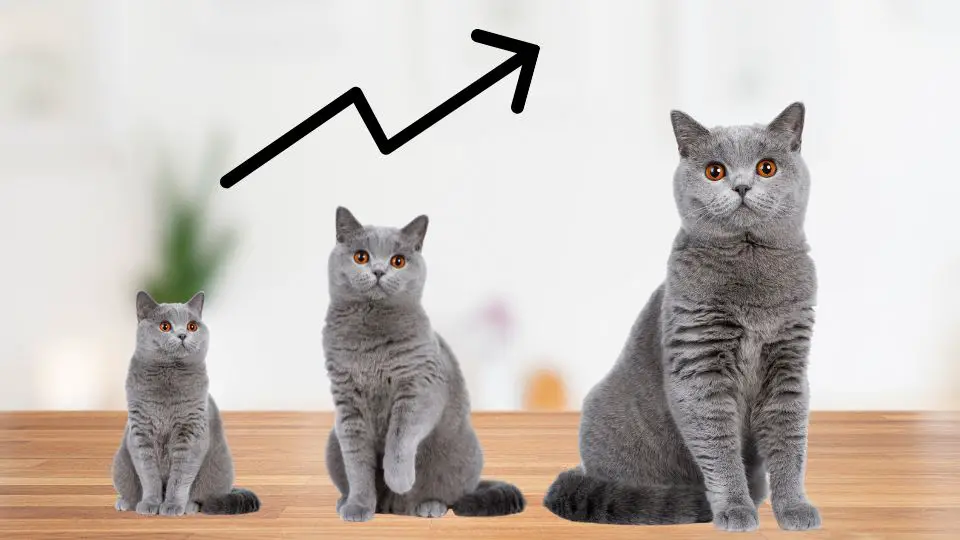British Shorthair cats have a dense, plush coat that requires regular grooming to keep it in good condition. While daily brushing can help remove loose fur and prevent matting, you may wonder how often you should bathe your British Shorthair to maintain optimal coat health and hygiene.
British Shorthair cats do not require frequent baths, as they are fastidious groomers and can keep themselves clean. As such, once a month, or even less often, should be enough.
However, there are some situations where a bath may be necessary or beneficial, such as if your cat gets into something dirty or smelly, or if they have skin or coat issues that require medicated shampoo.
Should British Shorthair be bathed?
British Shorthair cats generally do not require frequent baths, as they are fastidious groomers and can usually keep themselves clean.
It is important to assess your individual cat’s needs and consult with your veterinarian to determine if bathing is necessary or appropriate.
Factors to Consider When Deciding How Often to Bathe a British Shorthair
So, how often should you bathe your British Shorthair? The answer depends on a variety of factors, including your cat’s lifestyle, coat type, and overall health. Here are some general guidelines to help you determine how often to bathe your British Shorthair:
- Consider your cat’s lifestyle: Indoor cats who don’t go outside or come into contact with other animals may not need to be bathed as often as cats who spend time outdoors or live in multi-cat households. Similarly, cats who are prone to getting into messes, such as those who like to play in water or dig in the dirt, will need more frequent baths than those who are relatively clean.
- Take coat type into account: British Shorthair cats have a thick, plush coat that can trap dirt and debris, so regular brushing is important. However, because their coat is relatively short and doesn’t tangle easily, they may not need frequent baths to maintain its condition. If your British Shorthair has a longer or more prone to matting coat, more frequent bathing may be necessary.
- Assess your cat’s health: If your British Shorthair has a skin condition or allergy that requires medicated shampoo, your veterinarian may recommend more frequent baths to help manage the issue. However, you should follow your vet’s specific recommendations, as over-bathing can strip your cat’s skin and coat of natural oils and cause dryness or irritation.
How to Bathe a British Shorthair
Bathing your British Shorthair cat can be a daunting task, but with the right approach and some patience, it can be a successful and stress-free experience for both you and your cat. Here are some tips on how to bathe a British Shorthair:
Choose the right time
It is best to bathe your cat when they are relaxed and in a calm state of mind. Choose a time when your cat is not too tired, hungry, or playful. You may also want to schedule the bath for a time when you have plenty of time and won’t be rushed.
Gather supplies
You will need a cat-specific shampoo, a bucket or sink filled with warm water, towels, and a brush or comb. Make sure everything is within reach before starting the bath.
Brush your cat
Before the bath, brush your cat’s coat to remove any tangles, mats, or loose hair. This will help prevent matting and make the bath more effective.
Wet your cat
Use a cup or spray nozzle to wet your cat’s coat, avoiding their face and ears. Make sure the water is warm, but not hot or cold.
Apply shampoo
Use a small amount of cat-specific shampoo and lather it gently into your cat’s coat, paying special attention to any areas that may be dirty or have skin issues.
Rinse thoroughly
Rinse your cat thoroughly with warm water, making sure to remove all the shampoo. Be careful not to get water in their ears or eyes.
Towel dry
After rinsing, use a clean towel to gently pat your cat dry. You may also use a hair dryer on a low, cool setting if your cat is comfortable with it.
Reward your cat
After the bath, reward your cat with treats, toys, or praise. This will help reinforce positive associations with the bathing experience and make future baths easier.
Remember, bathing your British Shorthair cat should be done only when necessary and with gentle care. If your cat has any health or skin issues, it is best to consult with your veterinarian before giving them a bath.
Supplies needed to bathe a British Shorthair
To bathe a British Shorthair, you will need several supplies to ensure a safe and effective bathing experience. Here are the things you will need:
- Cat-specific shampoo: Choose a gentle, pH-balanced shampoo formulated specifically for cats. Avoid using human shampoos, as they may contain ingredients that can be harmful to cats.
- Towels: Have several towels on hand to dry your British Shorthair after their bath. Make sure the towels are soft and absorbent to avoid irritating your cat’s skin.
- Handheld showerhead or pitcher: Use a handheld showerhead or pitcher to wet and rinse your cat during the bath. Make sure the water temperature is warm but not hot, and avoid getting water in your cat’s eyes and ears.
- Rubber bath mat: Place a rubber bath mat in the bathtub or sink to provide a non-slip surface for your cat.
- Brush: Gently brush your British Shorthair before and after the bath to remove any loose fur and tangles.
- Treats: Use treats to reward your British Shorthair for good behavior during the bath. This can help make the experience more positive and enjoyable for your cat.
What to do when the British Shorthair doesn’t want a bath
It is not uncommon for cats, including British Shorthairs, to be resistant to baths. Here are some tips on what to do if your British Shorthair does not want a bath:
- Be patient: Never force your British Shorthair to take a bath. If they are not willing to cooperate, it may be best to try again at a later time.
- Make the experience positive: Try to make the bath experience as positive as possible by using treats and praise to encourage good behavior. Offer treats before, during, and after the bath to create a positive association with the process.
- Use a calming scent: Consider using a calming scent, such as lavender or chamomile, to help relax your British Shorthair before the bath. The market also offer a variety of special calming sprays for cats.
- Start slow: If your British Shorthair is new to baths, start slow by using a damp washcloth to gently wipe them down. This can help them get used to the sensation of water and make them more comfortable with the idea of a full bath.
- Use a groomer: If your British Shorthair is particularly resistant to baths, consider taking them to a professional groomer who has experience working with cats. They may be able to provide a more positive and effective bathing experience for your cat.
Remember that every cat is unique, and what works for one may not work for another. Be patient and persistent, and continue to offer positive reinforcement to help your British Shorthair feel comfortable and relaxed during the bathing process.
FAQs
Do British Shorthair cats like water?
British Shorthair cats are not known for their love of water. They are not a water-loving breed and may even be wary of water. However, like all cats, individual preferences can vary, and some British Shorthairs may enjoy water play or even enjoy being bathed.
Do British Shorthair cats like baths?
Some British Shorthairs may tolerate or even enjoy being bathed, but many do not. If your cat becomes stressed or anxious during the bathing process, it may be best to avoid baths altogether and instead focus on other grooming techniques, such as brushing or spot-cleaning with a damp cloth.
How often should British Shorthair cats be groomed?
At least once a week, using a metal comb and soft-bristled brush to remove any loose fur, dirt, or debris. This will help to prevent matting and keep the coat looking healthy and shiny.
During shedding season, which typically occurs in the spring and fall, more frequent grooming may be necessary to keep up with the increased amount of fur being shed. Some British Shorthair cats may also benefit from occasional baths, although this should be done sparingly to avoid drying out the skin and coat.
Conclusion
These cats are known for their fastidious grooming habits and generally do not require baths often than once per month. Over-bathing can strip their skin and coat of natural oils, leading to dryness and irritation. It is important to monitor their hygiene and cleanliness regularly and spot-clean as needed.
Consulting with a veterinarian or a professional groomer can also provide helpful tips and advice on how to properly care for your British Shorthair cat’s coat and skin. Remember, keeping your cat healthy and comfortable should always be the top priority.







